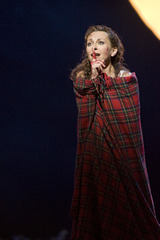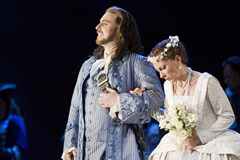| Opera Reviews | 27 July 2024 |
| Dessay
offers an exquisite Lucia by Sarah Noble |
|
| Donizetti: Lucia di Lammermoor San Francisco Opera 20 June 2008 |
|
|
Graham Vick's production, designed by Paul Brown, builds on this supernatural quality with a Lucia which, while recognisably Scottish, never feels entirely real. The people of Lammermoor are dressed for the period, but the world in which they move isn't nearly so concrete. Large flats, painted with storm clouds, slide horizontally and vertically to reveal (or conceal) a weather-beaten background; they also form the castle walls. Behind them is a heather-filled garden in which Lucia awaits Edgardo. In front, a few brutal pieces of furniture represent the fading Ashton manor. Principal cast and chorus weave in and out of this inhospitable setting, in which every boundary - inside/outside, real/imagined, sane/mad - is blurred. Lucia wanders directly from her garden assignation to Enrico's study without encountering a single door; her real Act I garden descends into the castle itself in Act III, now a product of her imagination and blooming with bloody crimson flowers. Above this perpetually half-lit scene hovers a huge, vaguely menacing moon. Jean-Yves Ossonce's muted, sometimes gloomy reading of the score sits well in this pleasingly pallid conception, emphasising the music's weird, ethereal side over its familiar bel canto rum-ti-tum. This approach does occasionally dull Lucia's passages of rage and machismo, but it's a perfect match to the distraction of the heroine herself. At the centre of this shadowy world is Natalie Dessay's astonishing Lucia,
luminous in her lunacy. A true and exceptional actress to the core, Dessay
does not settle for a one-dimensional characterisation. Her Lucia is no
mere victimised waif, but a spirited, multifaceted human being whose personality
(and with it her sanity) is gradually effaced by her forced subjugation
to all but her own desires. In her opening aria, she's already speaking
of spirits, but this seems less a forewarning of her madness than just
the extravagant imaginings of a girl who's read one too many Gothic novels.
Even as she's bullied by her brother into a loveless marriage, her manner
hints at a steely will which, were it not clouded by her gradual loss
of reason, might well show itself as strong as her tormentor's. Her mad
scene is at once disturbing and deeply touching, as she attempts in her
distraction to enact the wedding night with Edgardo she was never allowed,
before turning first on the company and then on herself. |
|
|
Dessay's colleagues are more conventional, though not without their share of talent. Giuseppe Filianoti brings fiery Italianate passion to Edgardo - both his voice and his stage manner are appealingly expressive, though sometimes becoming overwrought or unruly. He is at his best in his tormented "Tombe degli avi miei", though his subsequent death throes border on the cartoonish, including an ill-considered (and thankfully brief) falsetto. Gabriele Viviani's Enrico is more restrained, his strong but elegant baritone underscoring the threat he presents. He rarely moves beyond stock operatic gestures, but these at least are focused and personalised - and the conventionality of his stage presence beside Dessay's all too human Lucia is yet another reminder that brother and sister inhabit quite different worlds. Among the smaller roles, Oren Gradus is an engaging and mellifluous Raimondo, his "Dalle stanze ove Lucia" particularly impressive. Cybele-Teresa Gouverneur is a fetching and full-voiced Alisa, clearly accustomed to larger roles; she's appealingly vivid in her first scene despite having almost nothing to sing. Andrew Bidlack makes as much as he's able of the ill-fated bridegroom Arturo, preening and prancing in his luminescent white-and-gold livery before advancing upon a horrified Lucia. The Opera chorus sings with spirit and admirable clarity, especially in the climactic chorus which precedes Lucia's final entrance; that they pale into significance thereafter is no fault of theirs, but rather a testament to the magnetism of Natalie Dessay. And indeed it is to that magnetism that this production owes the magnitude of its ultimate success. Vick's bleak production has its spooky allure, and musical standards are basically strong across the board; but with an ordinary heroine it's unlike this Lucia would stay long in the memory. Natalie Dessay, however, is anything but ordinary, and her achingly exquisite Lucia is this production's beating heart. |
|
| Text ©
Sarah Noble Photos © Terrence McCarthy |

 With
its craggy moors, crumbling ruins and drifting, deranged heroine, Lucia
DI Lammermoor has all the makings of a good ghost story - except the
ghosts themselves. And yet Lucia is indeed haunted throughout by spirits
and spectres. None ever actually shows itself, but they are constantly
present in the thoughts and words of the living characters who populate
the opera's eerie landscape. They're conjured up in Donizetti's score,
too: nowhere more so than in the evocative music which surrounds the tortured
figure of Lucia herself, both in her spooky opening aria (a ghost story
in itself) and in her famous mad scene, where her own singing is accompanied
by the otherworldly strains of a glass harmonica.
With
its craggy moors, crumbling ruins and drifting, deranged heroine, Lucia
DI Lammermoor has all the makings of a good ghost story - except the
ghosts themselves. And yet Lucia is indeed haunted throughout by spirits
and spectres. None ever actually shows itself, but they are constantly
present in the thoughts and words of the living characters who populate
the opera's eerie landscape. They're conjured up in Donizetti's score,
too: nowhere more so than in the evocative music which surrounds the tortured
figure of Lucia herself, both in her spooky opening aria (a ghost story
in itself) and in her famous mad scene, where her own singing is accompanied
by the otherworldly strains of a glass harmonica.  Her
singing is similarly stunning and individualised. Dessay offers the best
of both worlds, bringing a cutting-edge theatrical sensibility to the
role without forgetting the traditional vocal demands of bel canto. Integrated
into this captivating characterisation are all the thrilling, radiant
displays of beautiful singing a person could wish for - gossamer pianissimi,
ravishing fil di voce, seamless legato and brilliant, passionate coloratura.
"Regnava nel silenzio" is hauntingly sweet, blooming into a delightfully
girlish "Quando rapito in estasi" with a thrillingly embellished final
cadenza. She encompasses captivatingly all the rapidly changing emotions
of the mad scene, from horror, to hushed eroticism, to illusory joy -
all of them animated by sensitive phrasing and a voice of limpid, shimmering
loveliness. Her wildly inventive cadenza (worked out in conjunction with
verrophonist Alexander Marguerre) is on its own almost worth the price
of admission.
Her
singing is similarly stunning and individualised. Dessay offers the best
of both worlds, bringing a cutting-edge theatrical sensibility to the
role without forgetting the traditional vocal demands of bel canto. Integrated
into this captivating characterisation are all the thrilling, radiant
displays of beautiful singing a person could wish for - gossamer pianissimi,
ravishing fil di voce, seamless legato and brilliant, passionate coloratura.
"Regnava nel silenzio" is hauntingly sweet, blooming into a delightfully
girlish "Quando rapito in estasi" with a thrillingly embellished final
cadenza. She encompasses captivatingly all the rapidly changing emotions
of the mad scene, from horror, to hushed eroticism, to illusory joy -
all of them animated by sensitive phrasing and a voice of limpid, shimmering
loveliness. Her wildly inventive cadenza (worked out in conjunction with
verrophonist Alexander Marguerre) is on its own almost worth the price
of admission. 





